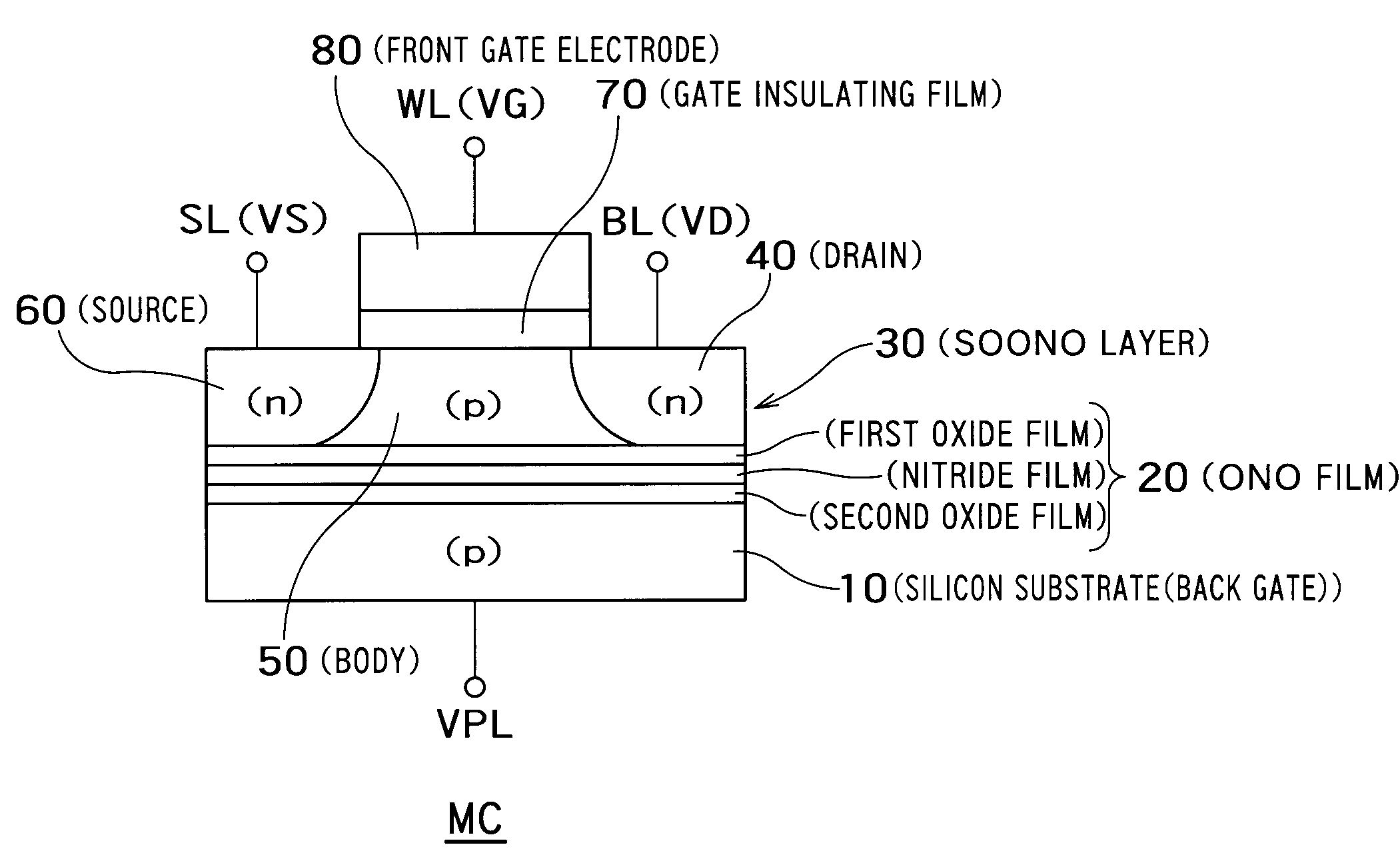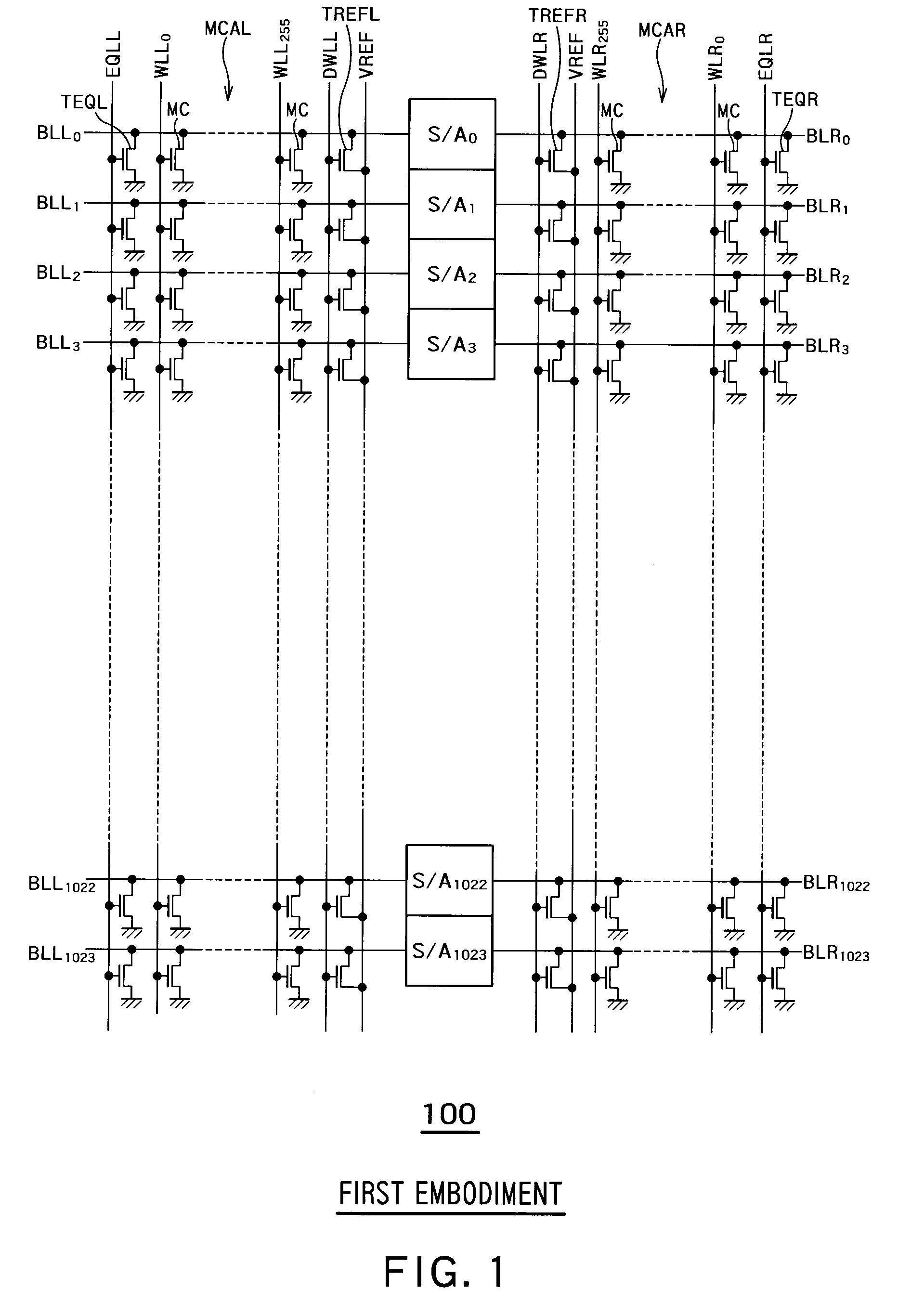Semiconductor memory device
a memory device and semiconductor technology, applied in semiconductor devices, digital storage, instruments, etc., can solve the problem of taking 500 microseconds (s) to program and erase data
- Summary
- Abstract
- Description
- Claims
- Application Information
AI Technical Summary
Benefits of technology
Problems solved by technology
Method used
Image
Examples
first embodiment
[0088]A memory cell according to a first embodiment of the present invention is configured by an MISFET formed on a silicon layer on a charge trapping film. A memory made up of such memory cells is a RAM which holds data dynamically depending on the number of majority carriers in the body region when a power supply is turned on. When the power supply is off, the RAM holds data depending on the amount of charges in the charge trapping film.
[0089]FIG. 1 is a schematic circuit diagram of an FBC memory device 100 according to the first embodiment. The FBC memory device 100 includes memory cells MC, word lines WLLi, WLRi (i is an integer) (also referred to as WL), bit lines BLLi, BLRi (also referred to as BL), sense amplifiers S / Ai (also referred to as S / A), dummy word lines DWLL, DWLR, reference potential lines VREF, reference transistors TREFL, TREFR, equalizing transistors TEQL, TEQR, and equalizing lines EQLL, EQLR.
[0090]The memory cells MC are arranged in a matrix to configure memor...
second embodiment
[0124]In a second embodiment of the present invention, an FBC memory device is shifted from the first storage state to the second storage state by the sequential save mode and from the second storage state to the first storage state by the sequential return mode. In the sequential save mode, a specific memory cell MC in the first storage state is selected by the word line WL and the bit line BL. The sense amplifier S / A reads the data stored in the memory cell MC (also referred to as selected memory cell MC). The sense amplifier S / A injects charges in the ONO film 20 based on the data. According to the sequential save mode, data is read from a selected memory cell MC in the first storage state. Data is programmed in the selected memory cell MC based on the read data. The memory cell MC is then shifted to the second storage state. These operations are performed sequentially upon all memory cells MC.
[0125]FIG. 10 is a flowchart of the sequential save mode and the sequential return mode...
third embodiment
Modified Example of Third Embodiment
[0180]FIG. 25 shows a memory cell array according to a modified example of the third embodiment. The modified example is different from the third embodiment in that the source line is driven selectively. FIG. 25 shows the voltage relationship when electrons are injected selectively in the ONO film 20 in the sequential save mode. In the modified example, a memory cell MC11 storing the data “1” and a memory cell MC 12 storing the data “0” are selected. A first voltage (e.g., 0 V) is applied to an unselected source line SL2. A second voltage which is higher than the first voltage (e.g., 1.7 V) is applied to a selected source line SL1. A third voltage which is lower than the first voltage (−1.7 V) is applied to unselected front word lines WL2 to WL4. A fourth voltage which is higher than the third voltage (e.g., 0.5 V) is applied to a selected front word line WL1. A fifth voltage which is higher than the fourth voltage (e.g., 3 V) is applied to the ba...
PUM
 Login to View More
Login to View More Abstract
Description
Claims
Application Information
 Login to View More
Login to View More - R&D
- Intellectual Property
- Life Sciences
- Materials
- Tech Scout
- Unparalleled Data Quality
- Higher Quality Content
- 60% Fewer Hallucinations
Browse by: Latest US Patents, China's latest patents, Technical Efficacy Thesaurus, Application Domain, Technology Topic, Popular Technical Reports.
© 2025 PatSnap. All rights reserved.Legal|Privacy policy|Modern Slavery Act Transparency Statement|Sitemap|About US| Contact US: help@patsnap.com



